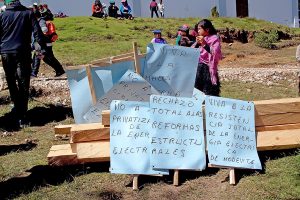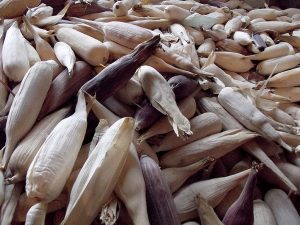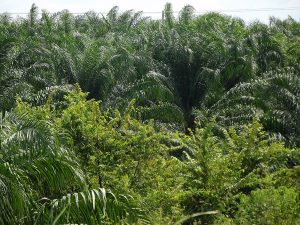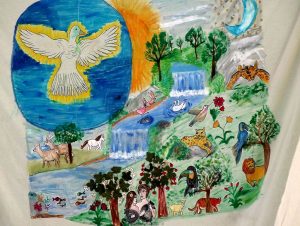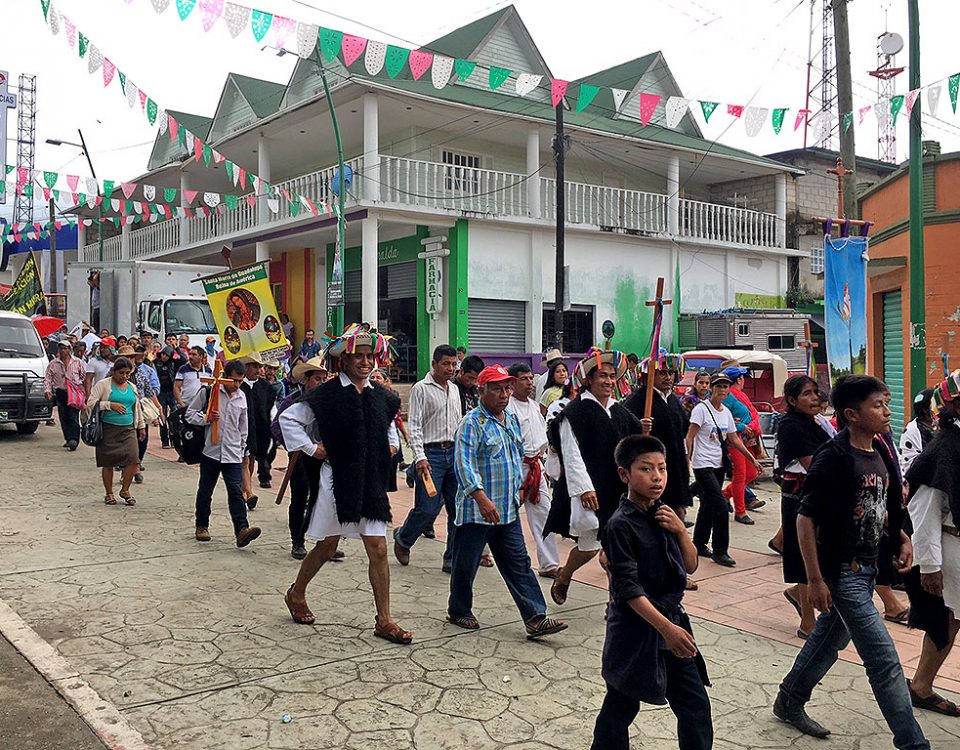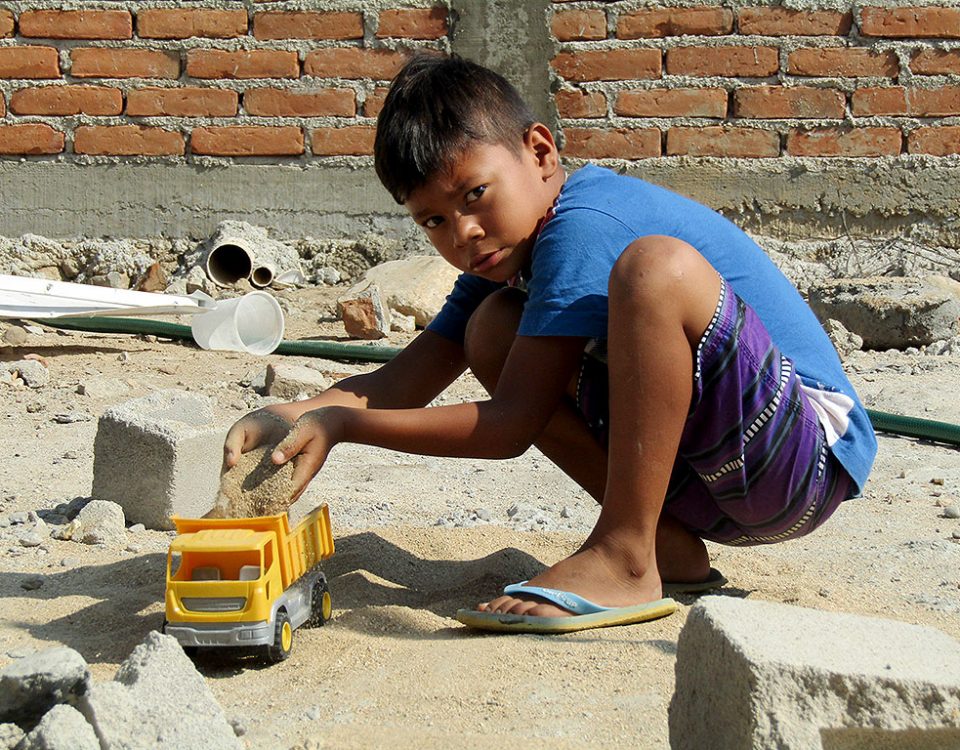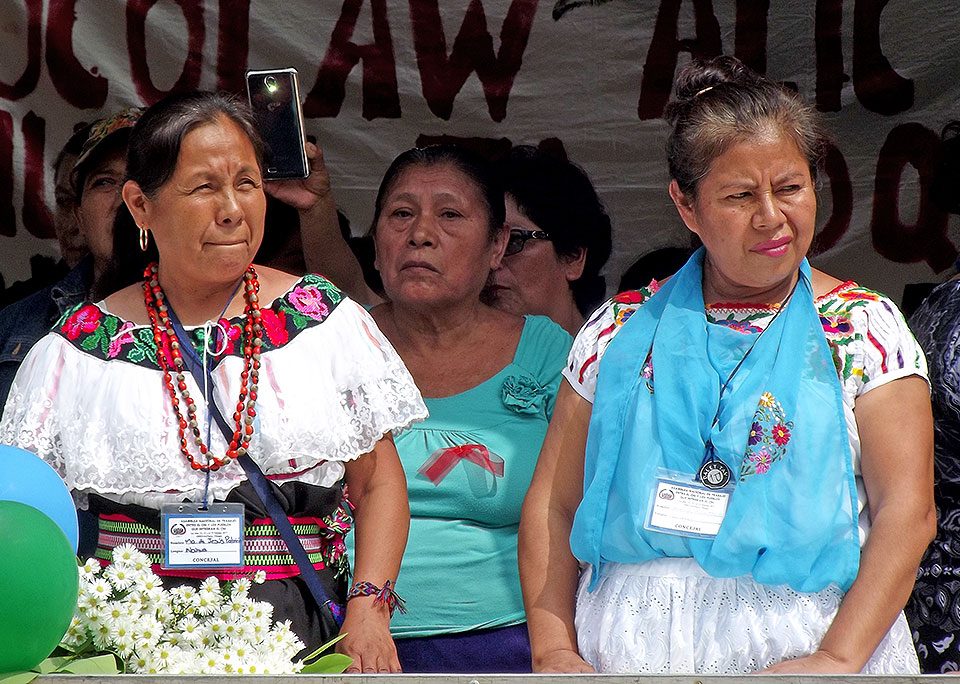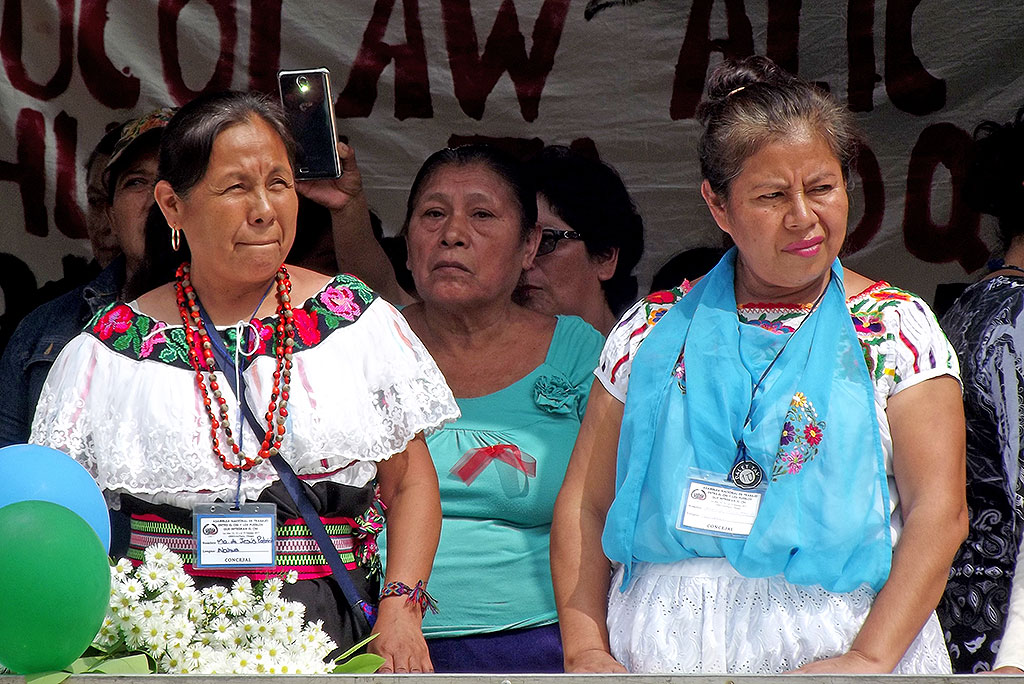
LATEST: Mexico – Strong Earthquakes Shake the Country
11/01/2018
ARTICLE: Earthquakes – The Admirable Mobilization of Civil Society
11/01/2018“When the last tree has been cut down,
the last sea polluted and the last fish has died,
mankind will realize that you cannot eat money.”
American Indian wisdom
The conservation, recovery and care of natural resources concern us all, without distinction of country, continent, occupation, social class, race or religion: THE EARTH CANNOT TAKE MORE. Our planet is being plundered, exploited and damaged with such “praiseworthy” excuses as development, alleviating hunger, improving the living conditions of peasants and their families, etc… The only hope for the planet, at this moment, depends on the conscience of its citizens, and in this, we can be inspired by the ancestral commitment of the native peoples in their care for “Mother Earth“.
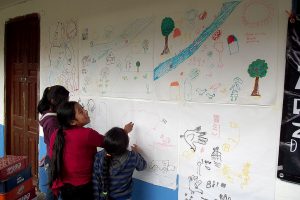
The importance of working with children and young people, Meeting of the Pastoral of Mother Earth, September 2017 © SIPAZ
After the Second World War, capitalism launched the so-called Green Revolution, an attractive name that finally materialized in technological changes in agricultural production, such as the use of pesticides, insecticides and chemical fertilizers, creating genetic changes in plants, aerial fumigation with pesticides, working with machinery that little by little was replacing or alleviating the work of farmers but deforesting bigger and bigger stretches of land.
We have to recognize that this brought about an increase of the Gross Domestic Product (GDP) of the countries and the world. However, these changes had harmful effects on the human health of both consumers and farmers, as well as soil fertility and ecosystems.
Pesticides, “serious environmental consequences”
According to the FAO, the term “pesticide” includes all chemicals used to destroy or control pests. 186 highly dangerous pesticides that contain carcinogenic substances and that have been banned in Europe or are not sold in other countries, because the companies that sell them refused to continue investing in tests that clarify what their effects are, are commercially registered in Mexico, according to a comparative study of the Action Network on Pesticides and their Alternatives in Mexico (RAPAM in its Spanish acronym).
It should be remembered that the FAO’s mandate is to improve nutrition, raise living standards, and promote agricultural development and food security. According to its 1997 report, “there is overwhelming evidence that the agricultural use of pesticides has important effects on water quality and causes serious environmental consequences.”
Among them is glyphosate. It is the most used herbicide worldwide and has been used since the 1990s. According to Greenpeace Mexico, it was created by Monsanto under the name of Roundup and its use has increased throughout the Americas as a result of the development of GMO crops such as soybean, corn and cotton. The World Health Organization (WHO) recognized that it can cause cancer in people and animals. It has been detected in the air and also in water and food as well as in the blood and urine of agricultural workers. It has a very high environmental impact as it damages the land and when filtered, it affects the quality of drinking water and aquatic animal life. The University of Indiana (USA) carried out a study that shows that glyphosate also affects pregnancy and embryonic development.
GMOs – no results without agrochemicals
Another element of change has been the development of transgenics. A transgenic (genetically modified organism or GMO) is a living organism artificially created with a technique that allows genes or viruses, bacteria, plants, animals and even humans to be inserted into a plant or an animal. The theoretical objective is to improve food production. Certainly, it has facilitated greater profits for companies like Monsanto, Bayer, Syngenta, Pioneer and Dow Agrosciences, which when developing these organisms try to control the basic grains that feed humanity such as corn, soybeans, canola, cotton, sorghum, rice and wheat. The seeds that are genetically modified give a higher yield, but for this they need certain inputs: chemical fertilizers, pesticides, herbicides and ensured irrigation.
In Chiapas, according to data updated in 2016 from the Secretary for the Countryside of the State Government, the government distributed 663,538 technological packages over six years, with an annual average of 165,884 whose investment reached 673,762,000 pesos. These packages are made up of a sprinkler pump, agrochemicals, fertilizers and modified corn seeds, which are delivered to the farmers as sunk costs from the “Sustainable Corn Program”, generating dependence on both agrochemical packages and government support. For most farmers, breaking the dependence on herbicides and fertilizers is practically impossible. As a result, it is unfeasible to work the land without them after using them, at least in the short term.
On the other hand, the Green Revolution opened the way to the patenting of modified and unmodified seeds, giving power to the transnationals to own and control any given species. Only ten companies dominate 95% of the world commercial seed market. According to Silvia Ribeiro, researcher of the ETC Group (Erosion, Technology and Concentration Action Group), with offices in Canada, the Philippines, Mexico and the United States, the 2007 Federal Seed Production, Certification and Trade Act (LFPCCS in its Sanish acronym), grants “certainty” to the transnational seed companies that they will be able to legally pursue any farmer that they consider to use their “inventions” without paying them (be they hybrid or transgenic seeds). The law establishes that private companies will certify seeds. On the other hand, there are those who consider that this law is only being implemented partially, because it would lead Mexico to a new Revolution because of the situation it would generate in the countryside.
Corn at risk
Biological considerations aside, corn is considered by the Original Peoples of Mexico and by all Mayans as the origin of life, as a gift from God. In particular, the story of the creation of man in the Popol Vuh, is based on corn and its colors from which “true men” are born. About ten thousand years ago, Mesoamerican man found that he could make hybrids with a conical-shaped grass, made up of different grains that grew wild: teocintle (which in Nahuatl means grain of God) was domesticated and gave way to corn, the staple diet of Mexico to this day.
59 varieties of corn are found here, so this country is its genetic reservoir, as the cultivation of transgenic corn would reduce the production of native grain, which would be at risk of contamination and extinction, this being a tragedy in terms of biodiversity and food sovereignty.
The Institute of Intercultural Studies and Research (INESIN in its Spanish acronym), shared with us its importance for the people in Chiapas, for whom the seeds are alive because they are generators of life, as opposed to the hybrid and transgenic seeds that are incapable of transmitting life from harvest to harvest. They are offerings and in them cultural identity is preserved, because in them the history of the ancestors is preserved, being kept generation after generation. Corn becomes, therefore, a gift from ancient peoples to the world.
Deforestation, another risk factor
Another element of the effects is the reduction of forests. It is an international problem and as Rockström mentions, “the causes of deforestation around the world are related to the increase in population and the change in land use from the original vegetation cover to agricultural lands.” In Mexico, despite having large areas of forest according to Greenpeace, “the pace of deforestation that Mexico suffers is one of the most intense in the world. According to the Institute of Geography of the UNAM, each year we lose 500,000 hectares of forests and jungles.” The Center for Social Studies and Public Opinion (CESOP in its Spanish acronym) points out that “Mexico occupies one of the first places in deforestation rates in the world at about 1.98 million hectares per year.”
In Mexico, the change in land use to convert forests into paddocks or fields is the main cause of deforestation nationwide. One example is the Lacandon Jungle in Chiapas, where about 6% (142,000 hectares) of tree cover losses occurred in Mexico, between 2000 and 2012. In this region, the number of localities increased by 8.9% from 958 to 1,043 between 2000 and 2010. Similarly, the number of inhabitants increased by 24.4% from 156,990 to 195,231 inhabitants (INEGI 2001 and 2011). This population growth has contributed to the process of loss of tree cover in the region.
Clandestine logging is one of the main factors in the Lacandon Jungle and in Mexico. According to Greenpeace Mexico, it is estimated that 70% of the national wood market has illegal origins. The figures from the Federal Protection Agency for the Environment (PROFEPA in its Spanish acronym) show that between “30 and 50% of the wood produced in Mexico is of illicit origin.” This means that out of every ten trees cut, approximately four are cut illegally. This trade is very lucrative and has a value of 2,650 million pesos per year.
One of the main reasons is that regulations are excessive and obtaining a permit has high costs for a commercial plantation. Producers who want to work according to the law are at a disadvantage because they cannot compete with the lower prices of illegal logging, coupled with the erroneous application of public policies and environmental legislation without punishment. Other causes are: the need for space for urbanization related to tourism projects or building houses and making furniture.
Another factor that has intensified deforestation in the Lacandon Forest is investments in monocultures, for example, starting in 2005, the European Union promoted African palm plantations under the Project for Integral and Sustainable Social Development in the Lacandon Jungle (PRODESIS), including in the buffer zone of the Lacandon Jungle and the Montes Azules Biosphere Reserve. In addition, the current governor of Chiapas, pledged to plant 100,000 hectares of African palm during his administration. Researcher Leon Enrique Avila, a specialist in African palm and a professor at the Intercultural University of Chiapas, mentioned in an interview with Animal Politico that the planting of palm in Chiapas does not include effective environmental control.
Another global problem is the loss of ecosystems that entails the loss of biodiversity in these ecosystems. According to the Federal Attorney for Environmental Protection (PROFEPA in its Spanish acronym), in 2010, there were 895 threatened species and 476 endangered species in Mexico.
Deforestation is also related to climate change. The forest soils are humid but can be dried quickly without the shade of the tree tops that help the water cycle, returning water vapor to the atmosphere. Without trees that play this role, many jungles and forests can quickly become pieces of dry land. In addition, the roots of the trees hold the soil together. For this reason felling them in mountainous regions increases the risk of landslides and threatens the lives of those who live nearby. Finally, trees play a crucial role in the absorption of greenhouse gases, responsible for global warming. Having less forests means emitting more greenhouse gases into the atmosphere and a greater speed and severity of climate change.
Once again, the problem is very complex and there are no magic solutions to it. The most feasible is to carefully manage forest resources by eliminating clearing to ensure that forests remain intact. This coupled with correct regulation, without corruption. Although not everyone agrees, a solution through reforestation with trees is an option. A criticism of this option is that it does not directly address deforestation and only tries to “compensate” or “replenish” the loss of forests, according to Greenpeace Mexico “the best option is to support Good Forest Management that thousands of communities and ejidos do in all of Mexico.” In this way the resources are managed by communities and ejidos that know the importance of their natural resources and know how to conserve them. An example is community-based forest enterprises that generate employment and profits that can be earmarked for works of common benefit.
Pollution and shared responsibility
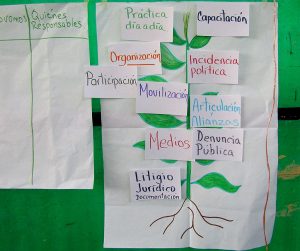
Possible actions in defense of Mother Earth, Encounter of the Pastoral of Mother Earth, September 2017 © SIPAZ
Humanity has made important advances thanks to technology, from Edison and his light bulb capable of lighting for more than 1,500 hours, to technological advances in medicine, for example, that allow people to live without problems with a apparatus in their heart that regulates their heartbeat for years. Now, as a society that consumes technology, we must be aware that our daily actions cause harm to the environment, for example, when we dispose of electronic devices, only because they are obsolete, we become accomplices and direct causes of the contamination of our planet. According to Eco2site “electronic devices cause massive pollution, due to the type of substances that are used in their manufacture. Frequently two groups of substances are used that are harmful to human health, to water, soil and the environment in general: polychromatic organic compounds, also called flame retardants and heavy metals such as lead, mercury, cadmium and chromium, as well as gold and arsenic.”
It has been reported that water contamination with toxic materials such as lead, cadmium or mercury is up to 190 times higher than that accepted by the World Health Organization. To contaminate water is to contaminate life itself. The entire biological, reproductive and nutritional cycles of man, animals and the sea are deeply affected. Currently, all the seas in the world are affected by oil spills for example. Today there are plastic islands in the oceans the size of the Mexican Republic, with millions of tons of floating waste.
The situation of pollution of the rivers in Chiapas is a problem that has worsened year after year, for different reasons, among them discharge of sewage into rivers and streams, lack of awareness of the population and insufficient and deficient actions of the authorities responsible for addressing this problem.
The general director of the National Water Commission (CONAGUA) Frontera Sur, Marco Antonio Parra Cota reported that in Chiapas 135 points of discharges of sewage have been identified, which affect 79% of rivers and streams belonging to the state of Chiapas, involving about 82 municipalities. He recognizes that: “Unfortunately in Chiapas, only nine municipalities treat sewage or part of it, so that about 30% of the population is in danger of suffering gastroenteric infections due to poor water quality.”
Oxfam establishes several causes that explain atmospheric pollution, among them: mining extractions, use of pesticides in agricultural activities, excessive industrialization, fuel combustion and deforestation. Some of these are examined in this focus. For the World Health Organization (WHO), air pollution represents a significant risk to health. It assures that by reducing the levels of air pollution countries can reduce the mortality rate derived from strokes, lung cancers and chronic and acute lung diseases, including asthma. It says that the lower the levels of air pollution, the better the cardiovascular and respiratory health of the population, both in the short and long term.
For some Native People of North America, if you are not spiritually connected to the Earth and do not understand the spiritual reality of how to live in it, it is likely that you will not survive. More than 95% of our body is water, to have good health we must drink a good amount and quality of water. The water is sacred. The air is also sacred. A tree breathes what we exhale and we breathe what it exhales, so when the earth, the water, the atmosphere are contaminated, they believe that the earth will react, because the Earth does not belong to us, we belong to the Earth.
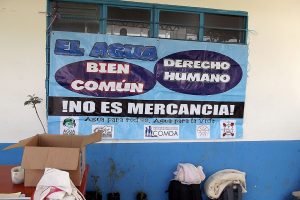
«Water, common good and human right. It is not a merchandise! », Poster in the framework of the Meeting of the Pastoral of Mother Earth, September 2017 © SIPAZ
We highlight only some initiatives carried out in Chiapas, such as the Congress of Mother Earth held in the community of La Candelaria, in September and promoted by the Pastoral of the Earth of the Diocese of San Cristobal de las Casas, where the causes and consequences that are directly involved in the crisis of the Planet were analyzed and concrete and feasible solutions were provided from the development of community plans in the different regions.
Other civil associations, such as Economic and Social Development of Indigenous Mexicans, (DESMI, A.C in its Spanish acronym), accompany processes and communities vindicating the campesinos. From an agroecological perspective, that is sustainable over time and that avoids dependence on the government to obtain supplies or to the agroveterinary ones when buying everything necessary to continue producing, based on an economy of solidarity that strengthens community cohesion and linkage.
In some cities such as San Cristobal de Las Casas or Tuxtla Gutiérrez in Chiapas, organic tianguis (exchange markets) are promoted in which producers and consumers interested in the consumption of chemical-free and environmentally friendly products are directly related.
Will we as humanity be able to change our lifestyle, production and consumption for our sake and that of future generations?


